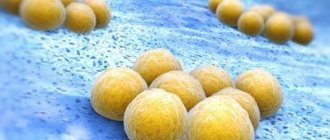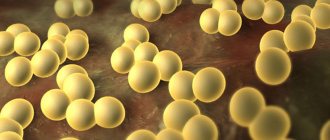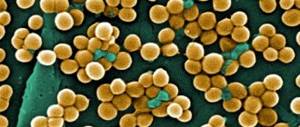Specific manifestations of staphylococcal infection are determined by the location of introduction, the degree of aggressiveness of the staphylococcus species and the degree of decreased immunity.
Pyoderma is one of the most common purulent skin diseases. Staphylococcal pyoderma is characterized by skin lesions in the area of hair openings. With superficial lesions, so-called folliculitis develops - a small abscess, permeated with hair in the center. With deeper lesions, a furuncle develops - a purulent-necrotic inflammation of the hair follicle and surrounding tissues or a carbuncle - inflammation of the skin and subcutaneous tissue around a group of hair follicles. Most often, boils and carbuncles appear on the back of the neck, thighs, and buttocks. The appearance of boils and carbuncles on the face is especially dangerous - due to the peculiarities of blood circulation, staphylococcus can be carried into the brain, with the development of purulent meningitis or brain abscess.
| Symptoms of pyoderma with staphylococcal infection |
Abscesses and phlegmon are a form of deep damage to the subcutaneous tissues with their purulent melting. The difference between an abscess and phlegmon is that in the first case, the inflammation is delimited by a capsule, which blocks the path to further spread of the process, and with phlegmon, purulent inflammation spreads through the tissues (that is, it is a more dangerous form).
Staphylococcal pneumonia is a rare phenomenon, but due to the characteristics of the course and the resistance of staphylococci to a number of antibiotics, it is of great importance among bacterial pneumonias. Pneumonia caused by staphylococcus is characterized by a severe course, with severe intoxication, chest pain (damage to the pleura), and shortness of breath. Multiple foci appear in the lung tissues, followed by purulent melting and the formation of abscesses. Such abscesses can break into the pleural cavity: a so-called empyema is formed.
Getting from the source of infection on the face, in the sinuses or other places through the bloodstream to the brain, staphylococcus causes the appearance of brain abscesses and purulent meningitis. Brain abscesses are usually small, scattered throughout the tissue. Meningitis is often secondary to a brain abscess, or can occur independently when a large number of staphylococci appear in the blood (bacteremia). Damage to the brain and its membranes is manifested by headache, impaired consciousness, neurological disorders, and epileptic seizures.
Staphylococcal infection can also cause thrombophlebitis of the superficial veins of the brain, accompanied by severe neurological disorders.
Staphylococcus is the main cause (up to 95%) of purulent inflammation of the bone marrow - osteomyelitis. In the process of inflammation, all layers of the bone are affected and destroyed, often the purulent focus breaks out. The main symptom of osteomyelitis is pain in the affected area. Later, tissue swelling appears over the site of inflammation, and purulent fistulas form. When joints are affected, purulent arthritis occurs, with the hip and knee joints most often affected.
Staphylococcal damage to the valves and inner lining of the heart (endocardium) endocarditis is a serious disease with a high (40-60%) mortality rate. Entering the bloodstream, staphylococcus quickly destroys the heart valve, causing serious complications in the form of embolism (blockage) of peripheral arteries, myocardial abscess, and heart failure.
Diseases caused by exposure to large amounts of staphylococcal toxins are sometimes classified as a separate group - intoxication. These include toxic shock and food toxicosis. Toxic shock occurs when particularly aggressive types of toxins enter the bloodstream, causing a sharp drop in blood pressure, fever, abdominal pain, nausea, vomiting, diarrhea, headache, impaired consciousness, and later a characteristic spotty rash appears. Food toxicosis occurs 2-6 hours after eating food contaminated with staphylococcus and is manifested by nausea, vomiting, diarrhea, and abdominal pain. In severe cases of food intoxication, the manifestations of enterocolitis may resemble those of a particularly dangerous infection - cholera.
Sepsis is the most severe form of staphylococcal infection, in which a huge number of bacteria are spread by blood throughout the body with the formation of multiple secondary foci of infection in the internal organs.
Staphylococcus is found on almost all surfaces of environmental objects. If you carry out a sanitary inspection of the apartment, the bacteria can be sown on household items, children's toys, medical instruments, mucous membranes of the oral cavity and skin. Moreover, pathogenic microorganisms can be detected not only in a sick person, but even in those people who do not experience obvious symptoms of an infectious disease. Cases have been repeatedly recorded where harmful bacteria were sown even in mother's milk, which was a source of infection for the child in the first days of his independent life.
What is the danger of Staphylococcus aureus?
At a normal level of functioning of the immune system, these microorganisms live on the skin and mucous membrane of a healthy person, and do not harm him, since blood leukocytes suppress their activity. As soon as the protective function of the body decreases, pathogenic microflora begins to master its new habitat and increase in quantitative composition.
It manifests its dangerous essence by provoking a strong inflammatory process in one or another part of the body, depending on the location of the largest number of bacteria. If such a staphylococcal lesion is not treated, then severe consequences may occur, including septic shock.
The high degree of harmfulness of staphylococcus is due to the fact that it has the following biological properties directly related to its life cycle in the human body, namely:
- These microorganisms have natural immunity to most antibiotics known to mankind.
- The bacterium can withstand boiling in water at a temperature of 95 to 100 degrees for 10 minutes and remains viable.
- Staphylococcus is not afraid of ethyl alcohol, hydrogen peroxide, shock freezing and drying.
- The microorganism produces its own enzymes such as penicillinase and lidase, which are actually an antidote to penicillin antibacterial drugs.
- The bacterium can literally melt a person’s skin and sweat glands, penetrating deeper into the muscle fibers.
- A by-product of the existence of staphylococcus is endotoxin, which has a toxic effect on the patient’s body. The presence of this toxin in the blood is characterized by symptoms such as elevated body temperature up to 39 degrees, headache, nausea, vomiting, and fever.
It is worth noting that immunity to this type of microorganism is not developed, and if the patient has once been cured of an inflammatory disease caused by Staphylococcus aureus, then with repeated infection a relapse of the disease is possible. These bacteria pose a particular danger to newborns who have not yet developed a strong enough immune system.
Once in the body of a small child, the infection affects the intestines and other organs of the digestive tract. Therefore, in gynecological and maternity departments, it is extremely important to comply with sanitary and hygienic standards.
Properties of Staphylococcus aureus
Pathogenic staphylococcus synthesizes and secretes many substances that allow this type of microbe to survive in the human body and damage its organs and tissues.
Enterotoxins
Staphylococci, contaminating food products (meat, milk), release enterotoxins, which, when entering the human body, cause food poisoning. Enterotoxins are resistant to high temperatures and human digestive juices.
Exotoxins
Staphylococci produce a number of exotoxins. Exotoxins have the following properties:
- damage the membrane of red blood cells, causing their hemolysis;
- damage leukocytes;
- damage the skin of newborns (Ritter's disease), the skin of children and adults (bullous impetigo);
- cause toxic shock syndrome.
Enzymes
Staphylococci secrete a number of enzymes with multidirectional effects:
- facilitate the adhesion of microbes to human tissues and the penetration of the pathogen deep into the tissues, damaging them;
— destroy the sebaceous plugs of hair follicles, which contributes to the penetration of infection deep into the tissues;
READ ALSO: Rash on the face of a baby: its types, causes and treatment
- cause the coagulation of areas of blood plasma around microbes, which, like a cocoon, envelops staphylococcus, protecting it;
- protect the microbial population from the action of antibiotics.
Allergenic components
Toxins and microbial cell components have strong allergenic properties, which contributes to even greater skin damage.
Breeding factor
Staphylococci contain substances that promote the proliferation of microbes in phagocytes - cells that protect humans from microbes.
Rice. 3. The photo shows a cluster of Staphylococcus aureus.
Causes of staphylococcal infection
In all cases, without exception, the reason for the development of pathogenic microflora in the human body is always the same - infection with a bacterium against the background of reduced immunity. The weakening of the body’s protective functions is facilitated by the presence of the following factors and conditions:
- long-term use of antibiotics or drugs based on synthetic hormones;
- frequent nervous tension;
- poor nutrition;
- vitamin deficiency;
- chronic diseases of the gastrointestinal tract;
- uncleanliness.
In order to avoid infection, you need to lead a healthy lifestyle, eat only biologically healthy foods, periodically undergo a course of vitamin therapy, and regularly take water treatments.
The last aspect is especially important to observe after visiting public places where large numbers of people gather daily.
Signs of infection
Symptoms of staphylococcal infection depend on which part of the body the greatest localization of harmful microorganisms occurs. General signs of the disease include symptoms such as fever, sweating, nausea, weakness, drowsiness, and headache. If a specific organ is damaged, then additional symptoms appear. Most often, Staphylococcus aureus exhibits its pathogenic activity on the following organs and parts of the body:
- Omphalitis. This is an infection with bacteria from the umbilical wound, which is present in newborns in the first days of their life. In such cases, there is extensive swelling of the umbilical ring with the release of pus.
- Pseudofurunculosis. This is the destruction by microorganisms of the structure of the sweat and sebaceous glands. Patients develop red, pus-filled formations that look very similar to pimples that are at the stage where the boil is about to burst. Most often, such formations appear on the skin of the face, back and head.
- Abscess. Extensive inflammation of the skin with infection penetrating into the muscle layer. When this formation is opened, a large amount of pus flows out.
- Felon. Infection with Staphylococcus aureus of the last phalanx of the finger of the upper or lower limb.
- Damage to the mucous membrane of the eyes. When the bacteria gets on the surface of the organ of vision, conjunctivitis develops, fear of direct rays of light, and when pressure is applied to the lower part of the eyelid, a yellow liquid with an unpleasant odor is released from the corners of the eyes.
- Inflammation of the upper respiratory tract. In particular, it is believed that Staphylococcus aureus is the cause of granular pneumococcal pneumonia, which is difficult to treat and often ends in death.
- Chronic rhinitis. Pathogenic microorganisms parasitize the nasal mucosa and provoke constant secretion of mucus from the sinuses. In more advanced stages, purulent inflammation is possible.
staphylococcal skin infection in the photo
In order to establish that it is staphylococcus that is the culprit of the disease, you need to undergo the appropriate tests. First of all, smears are taken from the patient’s wound, or from the mucous membrane of the mouth or nose, in order to carry out culture in the laboratory to determine the type of bacterial microflora.
Treatment
Considering that Staphylococcus aureus is naturally resistant to the action of penicillin antibiotics, the patient is treated with antibacterial therapy with synthetic penicillin. The category of these medications includes the drugs Amoxilav, Kefzol, Ceftriaxone. The timing of treatment directly depends on the severity of the disease, the number of microorganisms concentrated in the patient’s body, and the resistance of the patient’s own immune cells. In case of severe damage to the skin and internal organs, the period of drug therapy can last from 7 days to several months.
For purulent inflammation of the skin, the patient is prescribed treatment of wounds infected with bacteria with a solution of brilliant green and potassium permanganate. As a local treatment for damaged skin, Synthomycin and Oleandomycin ointments are used. If pathogenic microorganisms have penetrated deep into the muscle layer and the infection threatens to develop blood poisoning, the area of the body with suppuration is opened, the wound is cleaned of pus with surgical instruments, and treated with antiseptic agents. If necessary, sutures are placed on the exposed area of skin.
In case of staphylococcal infection of the digestive organs, the patient is prescribed gastric lavage. To replenish lost moisture, droppers from saline are placed. solution, glucose, rehydron. Antistaphylococcal toxoid is used as therapeutic methods. This drug is aimed at relieving the effect of intoxication until all bacteria are removed from the gastrointestinal tract. As a rule, complete cleansing of the intestines from staphylococcus occurs in 7 - 10 days. After recovery, patients are advised to take vitamins B, E and C to strengthen the immune system and prevent relapse of the disease.
The main cause of the pathology is Staphylococcus aureus toxin. The pathogenic microorganism is capable of settling on body surfaces and spreading to the ENT organs, pharynx, and urogenital tract. To prevent infection of the body, the immune system keeps the microbe under control. If its quantity exceeds the norm, immune cells accumulate in the lesion, suppressing division.
Not all people are susceptible to pathology. For this there must be predisposing factors:
- decreased immune system resistance;
- frequent use of medications without medical supervision (antibiotics, glucocorticosteroids);
- chronic diseases (diabetes mellitus, hepatitis, dermatitis);
- decreased thyroid function;
- living in poor environmental conditions;
- hypovitaminosis, vitamin deficiency;
- metabolic disorders;
- bad habits (alcoholism, drug addiction).
The condition affects the entire body. It leads to suppression of the function of internal organs.
The bacterium begins to multiply when it gets on the tissue. The process is provoked by an excessive immune response. Lymphocytes accumulate and begin to secrete inflammatory mediators. This leads to the following consequences:
- inflammation;
- edema – formed due to the accumulation of exudate leaving the bloodstream along with immune cells;
- redness;
- itching is the body’s reaction to bacterial toxins, inflammatory mediators;
- pain.
If the immune system constantly reacts to a pathogen, this leads to allergies in adults and children to staphylococcus. The condition is dangerous; the microorganism can be found on any surrounding objects.
Further symptoms depend on the focus in which the bacterium accumulates. More often, suppuration develops, as the infection multiplies, trying to resist the body's defense reactions.
The following types of staphylococci are distinguished, which are dangerous due to the appearance of hypersensitivity in the body:
- epidermal (Staphylococcus epidermidis) – inhabits the skin, mucous membranes;
- saprophytic (Staphylococcus saprophyticus) – reproduces in the urogenital tract;
- aureus (Staphylococcus aureus) - a strain that often causes allergies, is dangerous due to penetration into internal organs and blood.
A laboratory test is performed to identify the type of bacteria causing hypersensitivity. During bacteriological research, biological material is inoculated on special nutrient media. As a result, not only the strain is determined, but also the sensitivity of the bacterium to antibiotics.
Staphylococcal infections are easy to get. There are the following ways to do this:
- contact-household – touching the human body or common household objects;
- airborne - the transfer of bacteria into the air and liquids, spreading to surrounding people (appears when sneezing, coughing, talking);
- food;
- sick leave – in a clinical setting, bacteria multiply faster due to the concentration of sick people, so dangerous, resistant strains are formed.
The most dangerous way of contracting Staphylococcus aureus in a child is a hospital infection. Cases of death of newborns exposed to infection have been recorded. If the action of the bacterium occurs at an older age, an allergy is formed.
The body's reaction depends on the source of spread of the infectious agent.
- Pseudofurunculosis. Bacteria penetrate the sweat glands, forming purulent formations. Visually, it looks like acne in the rupture stage. The pathology extends to the face, back, and head.
- Abscess. The condition appears on the skin, but with deep penetration it affects the muscles. When the abscess is opened, a copious amount of pus flows out.
- Felon. An allergic reaction occurs on the fingers of the limbs, they swell greatly and increase in size.
- Ophthalmological pathology. Conjunctivitis forms with the release of purulent contents. The patient experiences photophobia, swelling, inflammation, pain, and itching. In the morning, pus sticks together the eyelashes and has an unpleasant odor.
- Pneumonia. There is a granular distribution of bacteria throughout the alveoli. The patient's body temperature rises, shortness of breath and cough occur. The disease is difficult to treat and most often leads to death.
- Rhinitis. Bacteria multiply on the mucous membrane, causing purulent discharge of yellow and green color. If Staphylococcus aureus moves higher in the nose, frontal sinusitis, sinusitis, and sinusitis will occur. The condition develops against the background of frequent acute respiratory viral infections.
- Quinsy. Staphylococcus in the throat leads to pathology. With allergies, the tonsils become excessively enlarged and fester. The voice disappears. The throat is swollen.
- Damage to the gastrointestinal waste. If Staphylococcus aureus spreads into the intestines, causing an allergy, this leads to dysbacteriosis. A person develops diarrhea, abdominal pain, and flatulence.
If the disease is not treated in the early stages, the allergy will become chronic. Due to the dilation of blood vessels for the passage of lymphocytes, bacteria can enter the systemic bloodstream, which can provoke sepsis and pericarditis. Pathology will lead to the spread of a pathogen that causes pneumonia, meningitis, and sepsis.
If children are allergic to Staphylococcus aureus, they may develop the same pathogenic reactions as adults. But unlike them, there is an additional risk of developing the following diseases.
- Omphalitis. This is the penetration of infection into the umbilical wound immediately after the birth of the baby. Staphylococcus in newborns is accompanied by swelling of the umbilical ring. Pus is released.
- Ritter's disease. The baby develops patches of red skin all over its body. The surface of the epidermis flakes off and flakes off.
- Pemphigus. Blisters filled with serous contents appear throughout the body. Pathology occurs under the influence of toxins secreted by Staphylococcus aureus.
For children, allergies are more severe. The risk of death is higher. This is due to the low development of the immune system, which is unable to resist the infectious agent.
It is worth distinguishing between the concepts of “staphylococcal infection” and “staphylococcus allergy”. The true condition - infection by Staphylococcus aureus - is accompanied by high fever and is very dangerous. If antibacterial therapy is not prescribed by a specialist on time, the patient may face serious complications such as endocarditis, meningitis, toxic shock syndrome and blood poisoning. In turn, an allergy is a consequence of a previous staphylococcal infection and the result of the action of toxins accumulated in the body that the microorganism produces. Clinically, sensitization to a bacterial allergen is accompanied by skin manifestations (dermatitis), as well as bronchospastic syndrome.
Types of staphylococcus and routes of infection
The most common and dangerous types of staphylococci
As already mentioned, staphylococcus has many types and subspecies, however, the most common and dangerous are considered to be:
- sapphire staphylococcus;
- Staphylococcus epidermidis;
- Staphylococcus aureus.
Thus, sapphire staphylococcus predominates mainly in women, affecting the organs of the genitourinary system and kidneys. This type of staphylococcus is less dangerous and affects the tissues of the genital organs and the mucous membrane of the urethra.
Staphylococcus epidermidis can affect all mucous membranes of the human body and live on any area of the skin. With a strong immune system, the body is able to fight this type of staphylococcus bacteria on its own, however, if the immune system is weakened, it can cause serious diseases. The entry of this staphylococcus into the blood leads to inflammation of the mucous membrane of the heart .
Staphylococcus aureus is the most common and dangerous species, especially for infants and young children. It is capable of exclusively affecting all human organs and their mucous membranes. Causes severe inflammation and purulent formations. It is difficult to treat and resistant to antibiotics, high temperatures and disinfectants. It is also capable of affecting the skin, forming purulent abscesses in the form of barley and boils.
Sources and routes of infection with staphylococcus
Due to the fact that staphylococcus lives not only in the human body and on the human skin, but also on the surface of household and medical devices, the ways in which these pathogenic bacteria enter the human body and blood are very diverse. So, staphylococcus can be transmitted as follows:
- airborne;
- through household objects (contact-household);
- with air flow (air-dust);
- with food (nutritional);
- 5. when using non-sterile medical devices (artificial).
When entering the body by airborne droplets, the source of infection is an infected person. Bacteria are released into the air when you sneeze or cough. Once on the mucous membranes of the respiratory tract, bacteria can cause sore throats, laryngitis, tonsillitis, bronchitis and pneumonia .
In case of contact-household infection, the sources are common food items (spoons, forks, cups, plates), as well as toys. Most often, children (when using toys of a sick child) and family members who are infected with staphylococcus are susceptible to such infection. This is due to the fact that pathogenic bacteria are resistant to the environment and disinfectants, even with careful processing. Thus, bacteria enter the mucous membranes of the mouth and pharynx and penetrate the digestive organs. They can cause inflammation of the mucous membranes and severe poisoning with digestive disorders.
Infection by airborne droplets is possible during prolonged stay in a room where an infected person is located. Bacteria enter the body with the air flow when inhaling. This route of infection is as common as airborne infection and causes the same diseases.
Staphylococcus can enter the body through food. This route of infection is called nutritional. Bacteria can be found both on the surface of foods (fruits and vegetables), and in raw meat, eggs and milk. Also, pathogenic bacilli can be found in raw water. Therefore, water and milk must be boiled; before eating raw fruits and vegetables, they should be thoroughly washed and doused with hot boiled water, and the meat should be subjected to long-term, repeated heat treatment.
An artificial route of infection into the body is possible when using unsterile or poorly processed medical instruments. Due to the use of such instruments, staphylococcus enters the blood and spreads along with the lymph throughout the circulatory system. It can cause serious diseases associated with inflammation of the mucous membranes of human internal organs, as well as inflammation of the mucous membrane of the brain, causing purulent formations on it.
Whatever the route of transmission of the disease, it entails serious consequences in the form of various diseases. Therefore, it is so necessary to take precautions when coming into contact with infected staphylococcus and not to forget about personal hygiene and food processing methods.
Symptomatic picture of staphylococcus in various diseases
Staphylococcus is capable of infecting various organs and causing a large number of diseases, therefore the symptomatic picture of staphylococcus depends on the disease caused.
Thus, when a person’s skin is damaged, the following symptoms appear: inflammation of the sebaceous glands and hair follicles; purulent abscesses in the form of barley and boils; hyperemia of affected tissues; pain in inflamed areas; slight increase in body temperature; Nausea and vomiting may sometimes be present.
When the upper and lower respiratory tract are affected, the following are noted: a significant increase in basal temperature (in acute cases, the temperature can rise to critical levels); hyperemia and swelling of the soft palate and tonsils; structural changes in the tissue and size of the tonsils; the formation of a purulent-inflammatory process in the mucous membrane of the pharynx and tonsils; purulent nasal discharge; inflammation of the mucous membrane of the bronchi and lungs; general weakness and intoxication of the body; severe dry or wet cough with purulent sputum.
Inflammation of the skeletal system occurs in the form of osteomyelitis, which is accompanied by purulent-necrotic inflammation of bone tissue and bone marrow. The person also experiences the following symptoms: a slight increase in temperature, pain in the affected areas and impaired movement.
When the digestive organs are damaged, severe poisoning of the body occurs and the following symptoms are noted: temperature rise to critical levels; severe vomiting; nausea; severe stool upset; change in the color and consistency of the stool (the stool changes to a liquid consistency and has a predominantly green tint); severe hyperemia and swelling of the tissues of internal organs; severe cutting pain in the abdomen; severe intoxication and weakness; lack of appetite; Sometimes there may be convulsions, dizziness and short-term loss of consciousness.
When the genitourinary system is damaged in women, the following is observed: profuse, thick leucorrhoea with an unpleasant odor; violation of diuretic function; itching and burning in the genitourinary tract; cutting pain when urinating; inflammation of the mucous membranes of the bladder and vagina.
Thus, among the generally accepted symptoms in the development of diseases caused by staphylococcus are:
- the presence of staphylococcus bacteria in the mucous membranes or blood;
- inflammation of the mucous membranes;
- significant increase in body temperature;
- severe intoxication of the body;
- general weakness;
- long-term course of the disease (associated with bacterial resistance to the antibiotic);
- lethargy of symptoms at the beginning of the disease.
Before starting treatment, it is necessary to consult a doctor and conduct a series of diagnostic studies. This will allow you to determine the exact nature of the disease, and the doctor will be able to prescribe the correct treatment. You should not self-medicate, especially in relation to children. Improper treatment can lead to even more severe complications and further spread of infection.
Diagnosis of staphylococcus
Staphylococcal infection in the human body is determined by conducting various tests and tests . These tests depend on the disease it causes. Thus, in case of damage to the respiratory organs, bacterial cultures and swabs from the nasopharynx cavity are carried out, as well as bacterial cultures of sputum discharge. For infections of the digestive system, vomit and feces are analyzed. If we are talking about infections of the genitourinary system, then urine and smears from the vaginal mucosa are taken for analysis. To determine staphylococcus in the blood, a general blood test is performed. This analysis is necessary when the skeletal system and mucous membrane of the brain are affected.
Therefore, before treating staphylococcus at home, you should make sure that the disease is caused by these bacteria and has no other origin.
Diagnosis of the disease
Doctors find out what leads to pathological symptoms, Staphylococcus aureus or allergies. To determine the cause, a general examination and laboratory tests are performed. They will tell you how to distinguish hypersensitivity.
- Anamnesis collection. Patients or parents tell the doctor about bothersome symptoms. More often they complain about the spread of acne and suppuration.
- General inspection. If Staphylococcus aureus multiplies in a patient and an allergy begins, not only purulent rashes are observed, but also signs of an excessive reaction of the immune system. Extensive swelling, inflammation, redness, and itching appear.
- General blood and urine analysis. They contain an increased number of leukocytes, indicating immune hypersensitivity. The ESR rate increases, which indicates inflammation of a bacterial nature. If the leukocyte count has an increased number of eosinophils and mast cells, an allergy is suspected.
- Bacteriological examination for Staphylococcus aureus. Part of the selected exudate is inoculated on special nutrient media. After incubation for several days and additional tests, bacteriologists determine the exact type of staphylococcus and also determine sensitivity to antibiotics.
- Allergen test. It is used from 4 years of age. Types of allergens are applied to the wrist, determining which of them causes hypersensitivity. A pathological reaction can develop not only from staphylococcus, but also to other antigens.
Only after an accurate diagnosis should therapy be carried out!
Staphylococcus and staphylococcal infection in children are fundamentally different things!
The presence of staphylococcus in a child’s body is far from a reason to panic and run around pharmacies in search of the most expensive antibiotics. As we have already mentioned, more than 80% of the population carries staphylococcus on themselves or in themselves, and most of them never “bother” to get a staphylococcal infection in their lives.
The real development of staphylococcal infection in children is indicated not by a positive test for staphylococcus, but by the resulting symptoms of staphylococcal infectious disease :
- heat;
- the appearance of purulent mucus;
- redness;
- painful sensation (as a rule, it appears exactly in the place where the inflammatory process occurs).
This situation only means that your baby and staphylococcus coexist peacefully with each other, and the child’s immune system successfully controls this “settlement” of microbes in his body.
Treatment
If a person is diagnosed with staphylococcus, an allergy does not always develop. When infection is combined with hypersensitivity of the body, separate therapy is carried out.
In case of an allergic reaction to a bacterium, the following groups of drugs are recommended:
- oral antihistamines (Claritin, Suprastin, Erius, Zodak);
- antihistamine drugs intramuscularly in emergency cases (Suprastin);
- antiallergic eye drops to eliminate local reactions (Allergodil);
- hormonal drugs based on Dexamethasone, Hydrocortisone to suppress the inflammatory reaction (prescribed in emergency cases if conventional antihistamines do not work);
- enterosorbents that eliminate the allergen from the digestive tract (Enterosgel, Polysorb).
Medicines are not taken every day. They are prescribed only during periods of exacerbation of an allergic reaction.
A competent doctor prescribes an antibiotic based on the results of a laboratory test. Identify the exact type of drugs that will be effective. They are used topically or orally, depending on the patient’s condition and the degree of bacterial spread. Macrolides, cephalosporins, and penicillins are most often prescribed.
Based on the results of laboratory analysis, it is possible to identify not only antibiotics, but also bacteriophages to which staphylococcus is sensitive. They are used topically or orally. The product acts more mildly than antibiotics and does not cause serious adverse reactions. But their efficiency is lower. With the help of bacteriophages it is possible to cope with dysbiosis.
The following components are most often used from traditional medicine:
- herbal decoctions (chamomile, string, calendula, oak bark, coltsfoot), used topically and internally;
- eggshells used after boiling (useful as a sorbent);
- beekeeping products (honey, propolis) – have an antibacterial effect;
- Vishnevsky ointment - eliminates the accumulation of pathogenic flora, suppuration under the skin, drawing it out.
Traditional medicine cannot be used as the only treatment. They are used in combination with medications, but only with the permission of a doctor.
Prevention measures
With the help of prevention, you can eliminate the risk of an allergy in an infant to Staphylococcus aureus:
- choosing a quality birthing clinic to eliminate the risk of hospital-acquired staphylococcus;
- daily hygiene procedures to control the quality of leather surfaces and prevent the growth of bacteria;
- proper nutrition of the mother during breastfeeding so that the baby receives nutrients;
- absence of bad habits in the mother during pregnancy and breastfeeding;
- timely treatment of diseases, especially infectious ones.
Prevention methods will not eliminate the risk of staphylococcal allergies, but will reduce the risk of occurrence.
Allergy staphylococcus
Staphylococcus and allergies are diseases that have similar symptoms. Staphylococcus aureus is an infection that appears in both adults and children. This disease is caused by a special microbe that is quite widespread in nature and is pathogenic. Staphylococcus aureus can cause inflammation of any organ or system of the human body, from the skin to the brain. Toxins that appear during illness provoke food poisoning.
Symptoms of staphylococcus: purulent formations. Allergies also occur when a patient comes into contact with a specific irritant, and can also cause damage to the skin and any internal organ of the human body. An important difference between these diseases is that Staphylococcus aureus is an infectious disease, while allergies are an exclusively individual disease and manifest themselves in a person depending on the level of susceptibility to different allergens. In rare cases, allergies can be inherited genetically.
What kind of “beast” is staphylococcus?
Staphylococcus is a bacterium, a special microbe. It coexists with humans as closely as hundreds of other microorganisms. There are a great many varieties of staphylococcus - today doctors already know about 27 species of this microbe. Of these, about 14 constantly live on the skin and in the human body, and of these 14, only 3 are considered potentially dangerous to human health. Moreover, there is no organ in the human body (and in particular a child) where staphylococcus cannot live and reproduce .
Staphylococcus in children can cause an impressive number of various diseases - from a common pimple on the skin to inflammation of the kidneys, from an intestinal infection to purulent meningitis and so on. There are also “sores” that are caused only by staphylococcus (and most often by Staphylococcus aureus) and no other microbe - for example, barley in the eye, a boil on the skin, and others.
But there is no reason to be afraid ahead of time. Since (we repeat!) only three types of staphylococcus are really dangerous to the health of adults and children. Moreover, even their detection in the human body does not mean the development of an infection - special conditions are required for the onset of the disease. The main one is weakened immunity.
Moreover, according to the same WHO, one of the types of dangerous staphylococcus - namely Staphylococcus aureus - most often causes an infectious disease in people who are in hospital (about 35% of all cases of Staphylococcus aureus in children are registered in hospitals).
Simply put, the greatest chance of catching Staphylococcus aureus occurs not just anywhere, but in a hospital ward. After all, one of the conditions for the potential development of infection is a weakened body with low immunity. Where do people (including children!) with weakened immune systems “gather”? Of course, in medical hospitals.
Symptoms of diseases
With Staphylococcus aureus, the manifestation of certain symptoms will directly depend on where the harmful microbe has taken root and began to develop. Allergic symptoms, as a rule, begin to occur everywhere after the main irritant has entered the patient’s body.
Unlike allergies, staphylococcus affects almost all organs and systems of the body. Pustular formations appear on the skin, as well as small follicles. Most often they develop on the neck, buttocks and in rare cases on the face.
Very often, the disease can be accompanied by pneumonia, which is quite resistant to therapeutic influence, which will very quickly lead to death. If the brain is damaged, staphylococcus can very easily develop into meningitis, which is accompanied by frequent headaches, vomiting, and nausea.
Another symptom of the disease may be damage to the joints with purulent formations, as well as pathological fractures and fistulas.
The symptoms of an allergic disease will depend on the substance to which the reaction occurs. If, for example, there is a food allergy, then it will be accompanied by vomiting and abdominal pain. With allergic rhinitis, the following symptoms are observed: runny nose, nasal congestion, and discharge. Allergic conjunctivitis is accompanied by swelling of the eyelids and increased lacrimation.
Hives what to do?
Hives are a common form of immediate allergic reaction, experienced by about 20% of children.
Urticaria manifests itself in the form of a sudden appearance of blisters on the skin, which are covered with a bloody crust and severe itching. Causes of urticaria:
Hives can be a reaction to a food allergen (fish, chicken, nuts, citrus fruits, apples, carrots, smoked products), a reaction to food additives to products: preservatives, dyes, flavorings, thickeners, etc. Hives can be a reaction to insect bites, nettle burns. Medicines, viral infections, heat, cold can also cause hives.
Diagnosis and treatment of the disease
To identify allergies, laboratory tests should be carried out in the form of prick tests and blood and urine tests to detect immunoglobulin, a protein that provokes an allergic phenomenon.
To find out about the presence of staphylococcus, a coagulase test is done, as well as latex agglutination. Additionally, an ultrasound is performed.
The following are used to treat allergies:
Antibiotics of the penicillin group, as well as aminoglycosides, are used to treat staphylococcal infections.
In the treatment of both diseases, actions aimed at maintaining and strengthening the immune system are performed. Vitamin complexes and folk remedies are used as methods of maintenance. It is very important that the treatment plan is drawn up by an experienced doctor. Only in this case can you get an effective result.
Allergy staphylococcus
I read a lot of topics about this, but decided to create a topic for our case. I would be very grateful for your answer!
We went to the garden in September. On September 3, a runny nose started and has not completely gone away to this day. The ENT diagnosed allergic rhinitis.
Swabs from the nose and pharynx were taken for microflora and sensitivity to a/b, a rhinocytogram (these tests were taken on the day the next runny nose began), and blood from a vein to determine allergens.
in the throat Staphylococcus aureus 10^7
some kind of tick - 1.
For some reason, the rhinocytogram turned out to be uninformative.
Frequent colds. Heredity is aggravated by CVD (this is true, my mother-in-law and husband are allergic). Nose. breathing will satisfy. The nasal mucosa has a cyanotic tint. The nasopharyngeal mucosa is swollen. Adenoids grade 1-2 (before this, no one diagnosed us with this.). Hypertrophy of the palatine tonsils, stage 1. Diagnosis: allergy. rhinitis. Carrying evil. stuff in the nasopharynx.
-erius 0.5 tsp. at night 2 weeks
-dex-gentamicin 2 drops in the nose. 3-4 times a day 7 days
-then intranasal Bactroban ointment 3 times a day for 7 days + irrigate the pharynx with Octenisept solution 3 times a day for 7 days
-then staphylococcal bacteriophage in the nose 2 drops + irrigate the throat 3 times a day for 10 days
-rela-life 1 t. per day with meals for 2 weeks (this is just in case, what if the stuff is also in the intestines).
Now the child is bothered by nasal congestion ONLY at night, mucus does not come out, snot does not flow, but flows along the back wall and this causes coughing at night.
One of the drugs used to treat allergic rhinitis is Avamys - this is a topical steroid. There is no need to be afraid of prescribing topical steroids. This is an effective and safe therapy.
And saline solutions for rinsing the nose are also effective, but I don’t know if they are prescribed for children, Valentin Sergeevich will say.
temperature is +20 degrees, humidity ranges from 40 to 55%, at night I hang a wet diaper on the radiator. The mattress, pillow and blanket are synthetic. A hypoallergenic lifestyle has almost been established. I do wet cleaning 3 times a week while my daughter is in the garden, windows all day long while the child is away. The only thing. We have a small dog, a blood test for the dog’s fur showed 0, but the allergist said that it could be that there is still an allergy to the dog (although we lived together for 2 years, nothing bothered us.).
can I try inhalation? or do they make no sense now?
We have been using Cromohexal since December 9, and I haven’t seen any results yet. We drink Zyrtec. Again there is no result.
After kindergarten, I put saline solution in my nose and blow my nose.
We donate blood regularly, hemoglobin has always been normal.
It seems to me that we have some kind of infection added to the al. rhinitis.
This morning one nostril was blocked. When we were able to blow our nose, greenish-colored mucus came out.
And I can’t figure out what to put on a child’s nose. Or donate blood first. You can’t get to a good ENT specialist, the appointment is already on January 5th. At the clinic, the ENT specialist will immediately prescribe Miramistin, which has already been tested. Wet cough in the morning and evening.
Maybe I should try Avamis after all? Is it indicated for green snot?
In general, the child feels well, is active, has a good appetite, he just says “I’m tired of this cough and snot”:ah:
Now the teacher called and told me to pick up my daughter; she was coughing constantly.
I took it. The cough is really terrible, although there was no cough either at night or in the morning.
In the evening we will go to the pediatrician, at least to the clinic, to listen to the lungs. No temperature. He grunts with his nose. The cough is sometimes dry, sometimes wet, sometimes it is so strong, barking, as if straight from the stomach. Sometimes he talks and it’s clear that he wants to cough.
Help me please! Which doctor should I go to? Maybe see a pulmonologist? What tests should I take? Should I do an X-ray?
In general, we have been coughing since November 2, but it was a rare cough, everything in the lungs was always clear, all the doctors we visited said that there was no need to treat the cough, they say it was caused by snot. But what I hear now doesn’t sound like it’s coming from snot.
I'll be looking forward to your answer!
I'll be looking forward to your answer!
first to the pediatrician, and then you need to go somewhere or not - an examination and time will tell
They were scared that there might be swelling at night and the child would suffocate.
sinecode, naphthyzin 3 times a day, 3 drops, inhalations with naphthyzin 3 times a day, whole drink.
I asked for a referral for a chest x-ray, the doctor immediately gave it, apparently she decided to play it safe. But she said that if there was bronchitis or pneumonia, then wheezing would definitely be heard. But since this is a long-lasting cough, you can get it checked.
What can you say about the prescribed medications?
I can’t find a FAQ topic about laryngotracheitis or stenosis. I think there is a lot of interesting stuff written there for me.
[Only registered and activated users can see links]
I decided to put off the x-ray for now, I’ll look at the condition. I don’t want to take an unhealthy child anywhere.
This means I will give Synecode, naphthyzin for 2-4 days, give him plenty of water, and humidify the apartment as much as possible. I will not do inhalations.
Thank you very much!:ax::ax::ax:
Please tell me whether Staphylococcus aureus, sown from the throat, could be the cause of a long-term cough in a child (the cough does not go away for almost 3 months). Otherwise, I so famously rejected his treatment, and yesterday I was just wondering if it would be worth treating him. and the cough would go away.
Treatment of Staphylococcus aureus in the nose
Drug therapy is prescribed only if high levels of bacteria are accompanied by purulent discharge and high fever. Treatment is carried out with antibiotics, immunostimulants, antihistamines, local means for rinsing and instilling the nose. In the absence of characteristic symptoms of infection, it is necessary to strengthen the immune system to prevent the active reproduction of Staphylococcus aureus. Folk remedies help effectively in such cases. Physiotherapy procedures are used as additional methods - phototherapy, laser therapy, electrophoresis, UHF.
The average duration of treatment for Staphylococcus aureus is 4 weeks.
During treatment for Staphylococcus aureus, it is necessary to adhere to a diet so as not to overload the body. Allowed foods are lean meat and fish, fermented milk products, slow carbohydrates, fruits and vegetables. Plenty of warm drinks are recommended - fruit drinks, compotes, table mineral water.
To speed up the healing process, you should stop drinking salt, coffee, and strong tea. Do not eat legumes, cabbage, or rye bread. These foods are difficult to digest and the body spends too much energy. Prohibited foods are junk food, hot spices, alcoholic beverages, fatty meats and fish.
Local remedies
For Staphylococcus aureus, antiseptics are prescribed for rinsing the nose. The drugs destroy bacteria, prevent their active growth, and moisturize the mucous membrane. Additionally, you need to use vasoconstrictor drops to eliminate rhinitis, swelling, and ointments with an antimicrobial effect.
List of external agents:
- Chlorhexidine
. Antimicrobial antiseptic with a wide spectrum of action, cleanses and disinfects mucous membranes, removes mucus. To rinse the nose, use a 0.05% solution. Carry out procedures 2-3 times a day for a week. - Chlorophyllipt
. The solution contains eucalyptus extract and is effective against streptococci. Place 3-5 drops into each nasal passage three times a day. The duration of treatment is 1 week. - Miramistin
- antimicrobial, antiviral agent with a wide spectrum of action. Rinse your nose with a warm solution morning and evening. Duration of treatment - 4-10. - Antibacterial ointment Fusiderm
- helps eliminate ulcers in the nose. Apply inside each nasal passage three times daily. The duration of the course is 1 week. - Bactroban
— antibacterial ointment based on mupirocin, destroys bacteria and prevents their reproduction. Lubricate each nostril morning and evening. The duration of the course is 3-5 days, sometimes 10. - Tetracycline, Erythromycin ointment, Baneocin
. These remedies must be used if the infection extends beyond the nasal mucosa. Treat the skin around the wings of the nose and in the nasolabial fold 2-3 times a day.
Nasal drops - Isofra, Protargol, Polydexa. They have antibacterial and vasoconstrictor effects. Place 2 drops in each nostril 2-3 times a day. The duration of treatment is no more than 10 days.
Systemic antibacterial drugs
Antibiotics are the drugs of choice for treating bacterial infections. But they are prescribed for oral administration in extreme, especially severe cases. If the norm of Staphylococcus aureus in the nose in adults is exceeded, signs of an infectious process are observed, and an analysis is prescribed to determine the sensitivity of pathogens to antibacterial agents. This helps to choose an effective medicine, since staphylococci are resistant to many antimicrobial drugs.
| Name | a brief description of | Admission rules |
| Amoxiclav | Semi-synthetic penicillin. The active ingredients are amoxicillin and clavulanic acid. | Dosage: 250 mg three times a day for 5-14 days. |
| Ofloxacin | Broad-spectrum fluoroquinolone. | Daily dosage: 200-800 mg, divided into 2 doses. Duration of treatment is 7-10 days. |
| Ceftriaxone | III generation cephalosporin. | The drug is administered intramuscularly at a dose of 1-2 g once a day for 7-10 days. |
| Sumamed | Antibiotic from the macrolide-azalide group. The active substance is azithromycin. | Dosage: 500 mg once a day. The duration of the course is 3 days. |
People with immunodeficiency conditions are prescribed strong antibiotics - Vancomycin, Teicoplanin. These drugs are effective against methicillin-resistant Staphylococcus aureus. But they have many contraindications and often cause negative reactions.
It is imperative to complete antibiotic therapy to the end, even if the symptoms of the disease have disappeared.
After completing antibacterial therapy, it is necessary to take a course of probiotics and prebiotics to restore the balance of the intestinal microflora. Effective drugs - Linex, Acipol, Maxilak. Additionally, you need to consume more natural fermented milk products.
Immunostimulants and antihistamines
Since the number of Staphylococcus aureus increases against the background of suppressed immunity, drugs must be included in therapy to activate the body’s protective functions. They are effective, but they must be taken strictly according to the instructions if there are serious indications. Otherwise, you can completely disrupt the functioning of the immune system.
Preparations to stimulate the immune system:
- Streptococcal bacteriophage
- used for the treatment and prevention of streptococcal infections. The medicine destroys bacteria; it must be dropped into the nose, or moistened in a turunda solution, and left in the nasal passages for an hour. - IRS-19
— nasal spray, increases specific and nonspecific immunity. Apply 2-5 doses into each nostril once a day. The duration of treatment is 2 weeks. - Taktivin
— immunoregulatory peptide for subcutaneous administration. The dose is calculated individually. The course of treatment is 5-7 days. - Polyoxidonium
- synthetic immunomodulator. Dosage - 1 tablet twice a day for a week. For the prevention of respiratory infections - 1 tablet per day for 10 days. - Antistaphylococcal immunoglobulin
is a drug for intramuscular administration. The dose depends on the severity of the infection and the person’s immune status. The course consists of 305 injections, they are given daily or every other day.
For staphylococcus in the nose, medications must be prescribed to prevent the infection from spreading to the larynx - Lizobakt, Miramistin, Furacilin. Antiallergic drugs are prescribed to eliminate swelling of the nasal mucosa. It is better to take the latest generation antihistamines - Levocetrizine, Fexofenadine. These medications do not have a sedative effect, act quickly, and the therapeutic effect lasts 12-24 hours.










